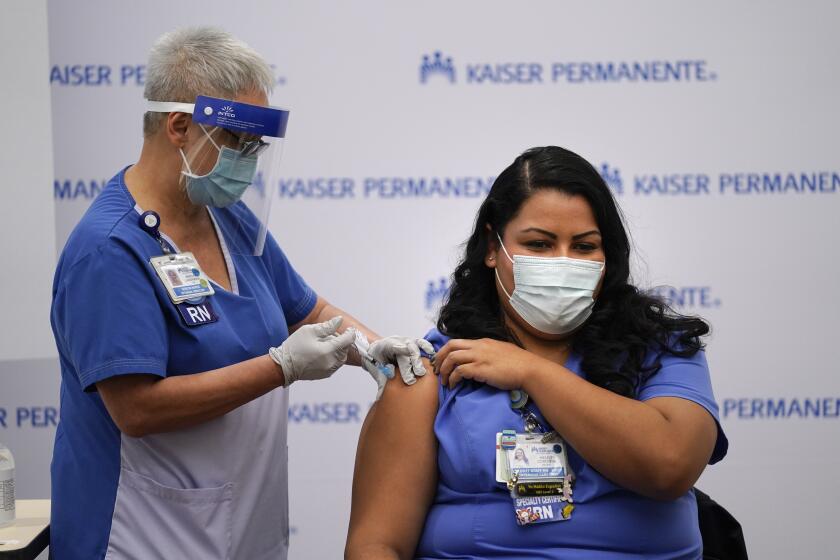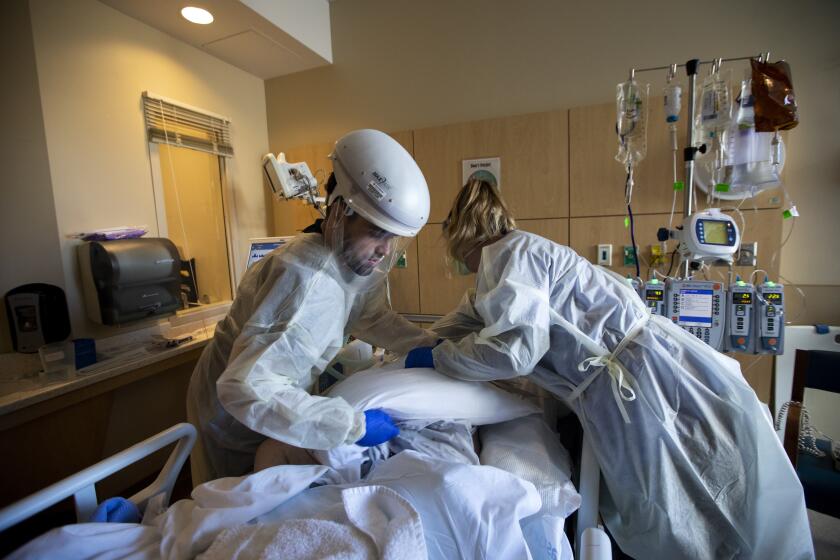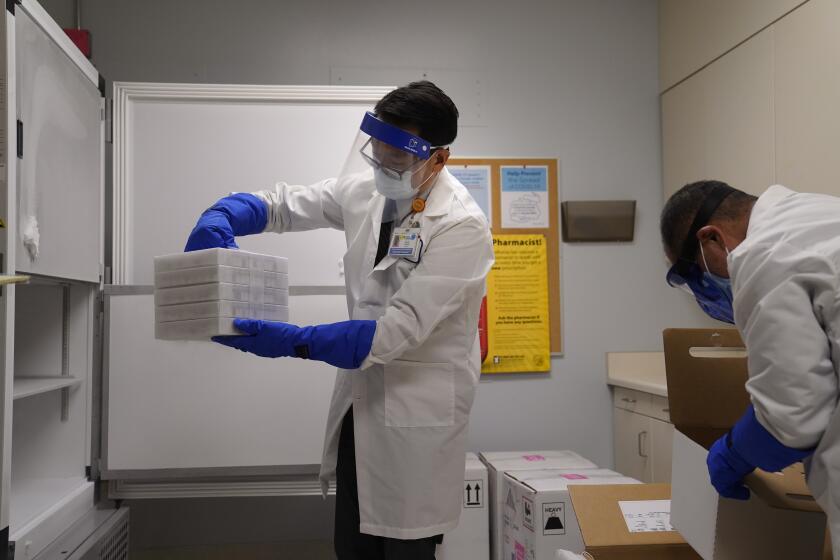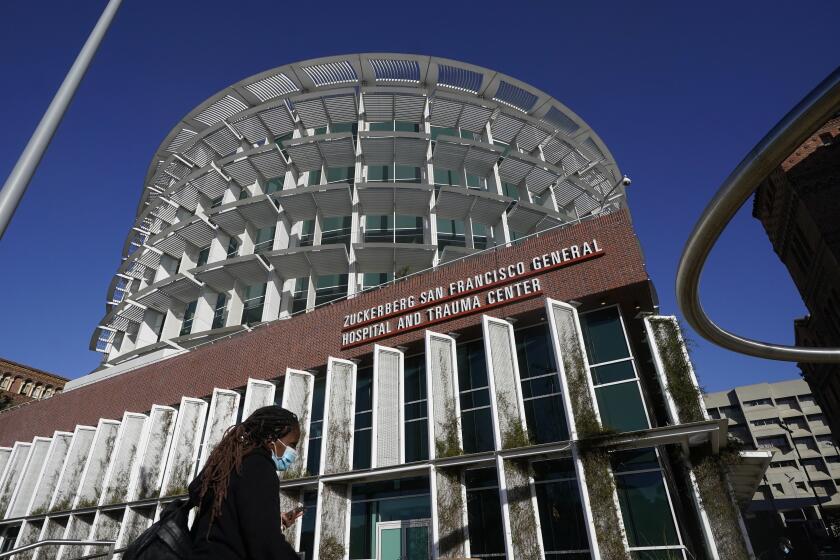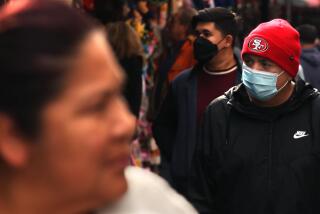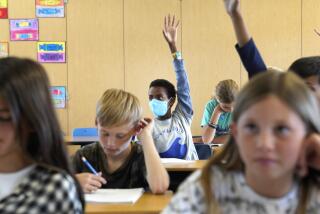California expects 1 million more COVID-19 vaccine doses this month
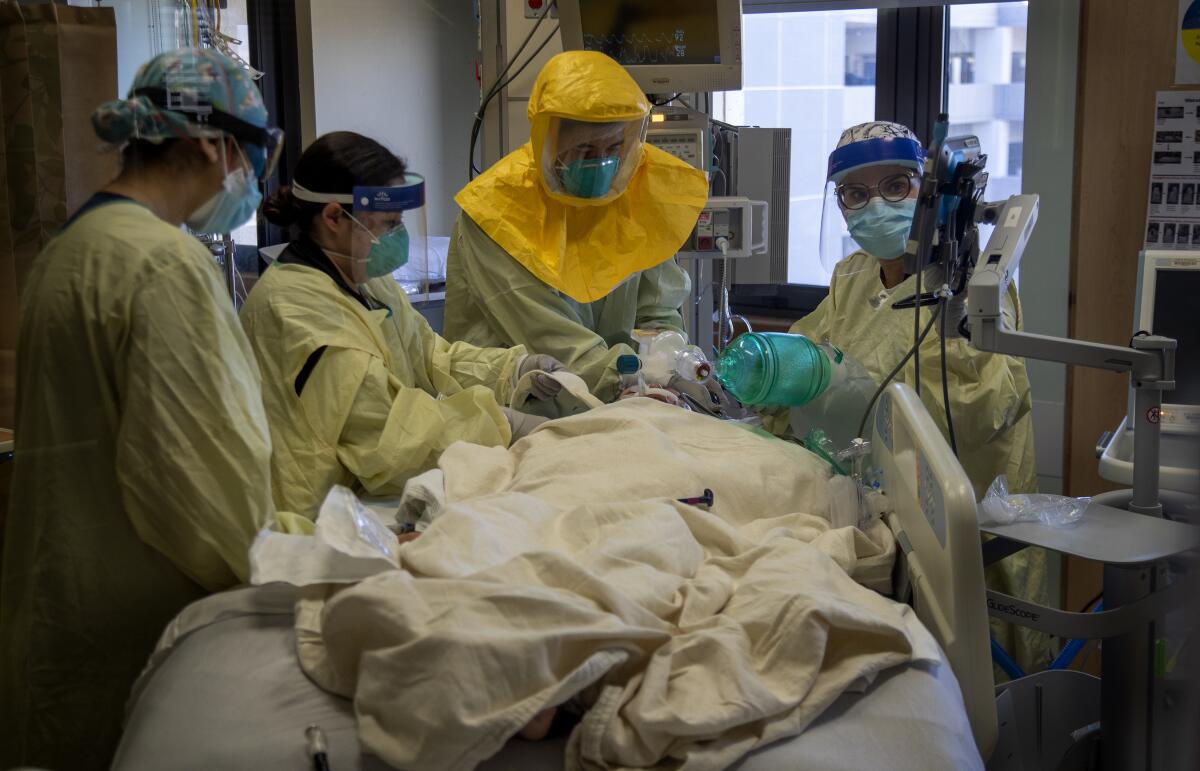
- Share via
California stands to receive at least 1 million more doses of COVID-19 vaccine by the end of the month, an influx that will help arm the state’s healthcare workforce against the most intense and severe wave of the disease yet.
The additional 393,900 doses of the Pfizer-BioNTech vaccine, as well as potentially 672,000 doses of the Moderna therapeutic — should it receive U.S. authorization, as expected — would supplement the state’s previously announced first allocation of about 327,000.
But that stream of vaccines, though welcome, will do little to dam the river of new infections that has flooded California in recent weeks. The supply remains limited and initially will be steered toward frontline healthcare workers and residents of long-term care facilities.
With a vaccine not expected to be available to the general public until at least the spring, Gov. Gavin Newsom emphasized Tuesday that Californians need to remain vigilant and double down on infection-prevention measures as the state wrestles with “the most challenging and difficult surge we’ve experienced since the beginning of this pandemic.”
“This is a deadly disease, and we need to be mindful of where we are in this current journey, together, to the vaccine,” he said during a briefing. “We are not at the finish line yet.”
But while the vaccine offers promise, it comes as the U.S. is facing the darkest moment of the coronavirus crisis. On Monday, the U.S. death toll topped 300,000, and California, like much of the nation, is in the throes of the worst wave of the disease.
Still, the arrival of vaccines provides a glimmer of optimism in a year that has had little and portends a time when the pandemic will be in the rearview mirror.
Facilities in four California cities — Los Angeles, San Diego, San Francisco and Eureka — received vaccines Monday. Twenty-four other sites were expected to get shipments Tuesday, and five more Wednesday.
San Francisco started administering the vaccine to frontline healthcare workers Tuesday, distributing a first batch of 12,675 doses to hospitals across the city.
“We are embarking on a vaccine distribution effort unlike anything this country or San Francisco has ever seen,” said Dr. Grant Colfax, the director of public health. “While this is a significant moment that we should celebrate, we have a long road ahead of us.”
Nearly 5,000 doses arrived Tuesday morning at UC Davis Medical Center in Sacramento. Eva Teniola, a clinical nurse in the emergency department, was the first employee to receive it. Teniola, 47, has been working at UC Davis for almost 10 years and said she has never seen anything as severe as COVID-19.
“People die alone, and it’s so sad,” she said. “They don’t have family because it’s strictly no visitors, so we have to stay with them.”
Cedars-Sinai in Los Angeles also received its first vaccine shipment Tuesday.
“The arrival of the COVID-19 vaccine signifies a powerful and positive shift change for our community after months of fear, exhaustion and illness,” Chief Operating Officer Dr. Jeffrey A. Smith said in a statement. “Until today, the vaccine was the missing tool in our ever-growing toolkit of treatments and prevention methods against the virus.”
Keck Medicine of USC and USC Verdugo Hills Hospital are scheduled to receive about 2,500 vaccine doses between them this week. Officials said they anticipate picking up the doses Thursday and starting vaccinations within four hours. The priority will be those caring for COVID-19 patients and those who work in high-risk settings or in areas where patients are being tested, according to Dr. Neha Nanda, medical director of infection prevention at the USC Keck School of Medicine.
“We have the vaccine; that’s amazing,” Nanda said. “It took more than 10 years to get the polio vaccine. ... Now, within nine months, we have a vaccine. It is going to change our lives.”
‘Our reality is frightening,’ says the county’s top health official as COVID-19 patients swamp Southern California hospitals.
Belying the hope that accompanies the vaccines, though, is the horror of a pandemic that is infecting, hospitalizing and killing unprecedented numbers of Californians.
Over the last week, an average of 164 Californians have died from COVID-19 every day, roughly quadruple the level seen a month ago, according to data compiled by The Times.
Amid the rising fatalities, Newsom said, the state purchased and distributed 5,000 additional body bags.
“It’s not the flu. This is not something to trifle with,” he said. “This is a deadly disease, a deadly pandemic.”
More than 21,200 Californians have died from COVID-19 — nearly 2,000 of them in the last two weeks.
The pandemic is wreaking havoc on healthcare systems up and down the state as the number of hospitalized patients continues to reach new heights. On Monday, there were 14,283 COVID-19 patients hospitalized in California; 3,081 of them were in intensive care. Both figures are record highs, representing increases of 73% and 63%, respectively, from two weeks ago.
As harrowing as those totals are, officials remain concerned about what may come next. Because of the lagging nature of the coronavirus, it typically takes an infected person about two weeks to fall ill enough to require hospitalization.
Over the last week, California has averaged almost 33,000 new cases per day, up 133% from two weeks ago. The state shattered its daily record for new cases Monday, with 42,129.
A Los Angeles Times county-by-county tally tallied 42,129 coronavirus cases across the state Monday. That’s the first time more than 40,000 cases have been reported by the state’s local health agencies in a single day.
Officials warn that if those recently infected require care at the same levels as those who preceded them, California is barreling toward disaster, with hospitals that are overwhelmed and professionals who are overworked.
Already, ICU beds across the state are plummeting. In the Southern California region — which the state defines as Imperial, Inyo, Los Angeles, Mono, Orange, Riverside, San Bernardino, San Diego, San Luis Obispo, Santa Barbara and Ventura counties — ICU capacity Tuesday had shrunk to 1.7%, officials said.
In the San Joaquin Valley, ICU capacity was at 1.6%, a meager figure but an improvement from Monday, when it was at 0% —meaning some critically ill patients had to be housed in hospital areas not designed to care for critical patients.
“Many folks may be thinking that this is just not anything to be really worried about, because hospitals can just add more beds. The reality is, every bed needs to be staffed by highly trained and skilled healthcare workers, and we don’t have an endless supply of healthcare workers, and those that are here saving lives every day are exhausted,” L.A. County Public Health Director Barbara Ferrer said Monday.
San Francisco begins administering the COVID-19 vaccine to frontline healthcare workers, distributing a first batch of 12,675 doses to hospitals across the city.
While the future seems brighter, Newsom warned that there are still dark days ahead and that residents need to do everything in their power to stymie the ongoing surge — including wearing masks in public, washing hands regularly, staying home when sick and keeping physical distance from, and avoiding gatherings with, those outside their household.
“Mark my words: We will come out of it stronger than ever,” he said. “We want to come out of it healthier than ever. We want you to be there to experience the resurgence, this recovery, California’s comeback. It’s right in front of us. But it’s also inside us. It’s our decisions, again, not just conditions, that will determine that fate and future.”
Times staff writers Brittny Mejia, Maura Dolan and Rong-Gong Lin II, as well as the Associated Press, contributed to this report.
More to Read
Sign up for Essential California
The most important California stories and recommendations in your inbox every morning.
You may occasionally receive promotional content from the Los Angeles Times.
